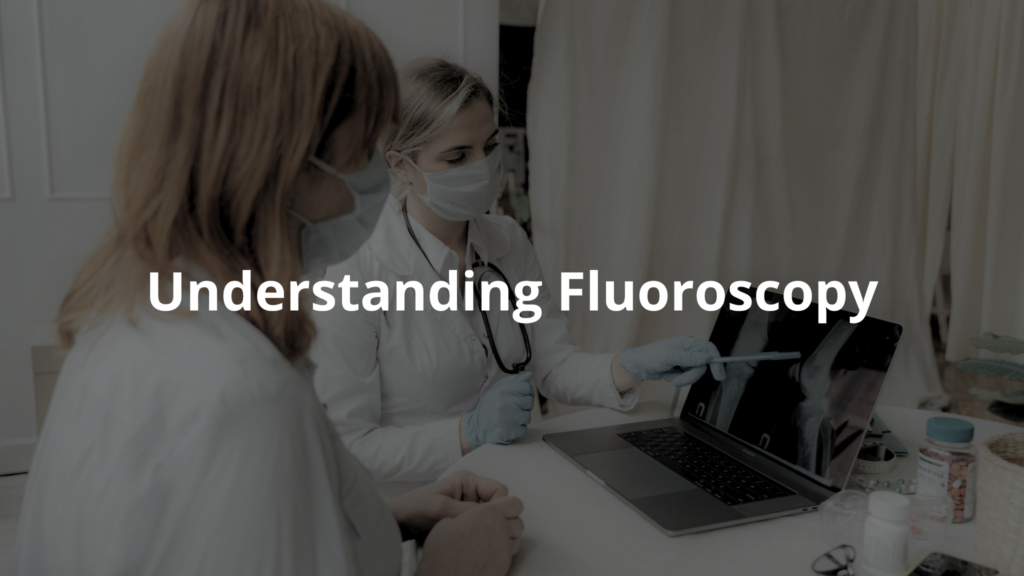Explore how fluoroscopy helps doctors see inside our bodies in real-time, making medical procedures safer and easier.
Fluoroscopy applications are pretty amazing. Imagine a special camera that lets doctors look inside your body while it’s moving! This is what fluoroscopy does. It helps doctors see how our organs work during different procedures. That’s super helpful when they need to diagnose or treat health problems.
In this article, we’ll look closely at how fluoroscopy works, its applications in healthcare, and why it’s a useful tool for doctors. Keep reading to learn more!
Key Takeaway
- Fluoroscopy shows real-time images of our organs and tissues.
- It helps in many medical tests and procedures.
- Safety is important to reduce radiation exposure.
Understanding Fluoroscopy

Fluoroscopy is like a magic window into the body. It uses X-rays to create moving pictures, allowing doctors to see how organs function in real time. This is really important, especially when they want to check things like how food travels through the GI tract. Imagine being able to see a piece of toast move from your mouth, down your throat, and into your stomach! That’s what fluoroscopy can show(1).
In Australia, doctors use this special imaging test in hospitals and clinics. It helps them diagnose many health issues. For example, if someone has trouble swallowing, a doctor might order a barium swallow test. During this test, patients drink a liquid that contains barium, which shows up clearly on the X-ray images. It’s fascinating to think how a simple drink can help doctors see inside a patient’s body!
I remember hearing about a lady named Sarah. She had trouble swallowing her food. It was really scary for her. The doctor ordered a barium swallow test. Sarah drank the barium, and then they took pictures of her throat. It turns out she had a small problem that was easy to fix. Fluoroscopy helped give her peace of mind and get her back to enjoying meals with her family.
Applications of Fluoroscopy
Fluoroscopy is a tool that shines in many areas of healthcare. It’s used for lots of different tests and procedures, making it very versatile. Here are some important applications:
1. Gastrointestinal Studies
Fluoroscopy plays a key role in studying the GI tract. Some of the common tests include:
- Barium Swallow: This test shows how well someone can swallow. Patients drink a barium solution, and the doctor watches how it moves down the oesophagus.
- Barium Enema: For this test, barium is introduced into the lower GI tract. This helps doctors check for any abnormalities in the colon.
- Small Bowel Follow-Through: This test helps assess the small intestine’s structure and function. It’s vital for diagnosing various digestive disorders.
It’s interesting to note that these tests don’t just help with diagnosis; they can also guide treatment options. Doctors can see how well the digestive system is working, and that can help them decide the best course of action for their patients.
2. Urological Procedures
Fluoroscopy is also really helpful with the urinary system. Two important tests are:
- Micturating Cystourethrogram (MCU): This test evaluates how well the bladder is working. It helps identify any issues with the bladder or urethra.
- Intravenous Pyelogram (IVP): This test uses a contrast dye to visualise the kidneys and urinary tract. It’s crucial for spotting any blockages or abnormalities.
I think about how this imaging helps people who might have embarrassing or painful conditions. It’s not fun to talk about bladder problems, but these tests can make a big difference in someone’s life.
3. Musculoskeletal Imaging
Doctors use fluoroscopy to get images of bones and joints, too! This includes:
- Joint Injections: Fluoroscopy is used to guide the needle for injecting medication into the joint. This ensures the medicine goes exactly where it needs to be.
- Arthrograms: These provide detailed images of joint structures. This is especially useful for athletes who might have injuries.
It’s amazing how fluoroscopy can help relieve pain. For instance, a sports player with a knee injury might get a joint injection guided by fluoroscopy. This can help them recover faster and get back on the field.
4. Interventional Procedures
Fluoroscopy is very handy for many interventional procedures. Some examples include:
- PICC Line Insertion: This is when doctors use fluoroscopy to place a special catheter in a vein. It’s important for patients who need long-term medication.
- Myelograms: This imaging helps visualise the spinal canal and nerve roots. It’s useful for diagnosing back pain or nerve issues.
I once heard about a patient named Tom who needed a PICC line. He was really nervous about it. But when the doctor explained how fluoroscopy would help place it safely, he felt much better. The procedure went smoothly, and Tom was grateful for the care he received.
5. Paediatric Applications
Children have unique needs during imaging tests. Hospitals, like the Perth Children’s Hospital, use fluoroscopy for paediatric studies, ensuring everything is safe and designed for younger patients. For example, barium studies help check for issues in children’s digestive tracts.
I think about how scary it can be for a child to go through a medical test. But with fluoroscopy, doctors can provide reassurance and make the experience as comfortable as possible. They might even use fun stickers or toys to help kids feel at ease.
Fluoroscopy is a valuable tool in healthcare, helping doctors see what’s going on inside the body. It’s fascinating how this technology can help diagnose and treat various conditions. Patients can trust that their doctors are using the best tools available to ensure their health and safety.
Safety and Regulations
Safety is a top priority in fluoroscopy, as this imaging technique uses X-rays, a form of radiation. While invaluable for seeing inside the body, X-rays require careful handling to minimise potential risks. In Australia, doctors and hospitals follow strict guidelines to ensure the safety of both patients and medical staff(2).
The Environment Protection Authority (EPA) oversees fluoroscopy practices, enforcing rules to keep radiation exposure as low as possible. These regulations include regular equipment checks and maintenance to ensure optimal performance. For patients, specific instructions such as holding still, holding their breath, or adjusting positions help create clearer images.
Key Safety Measures:
- Regulatory Oversight: EPA sets strict safety standards.
- Equipment Maintenance: Regular checks ensure proper functioning.
- Patient Preparation: Clear instructions on fasting or drinking solutions improve accuracy.
I recall my friend Jake undergoing a fluoroscopy test. Initially nervous, he was reassured by the staff’s explanation of the process and safety measures. He learned he’d need to drink barium for better imaging. Knowing the precautions in place eased his concerns.
With proper preparation and adherence to safety protocols, fluoroscopy remains a safe and effective diagnostic tool, giving patients peace of mind during their medical journey.
Conclusion
In the world of medical imaging, fluoroscopy is a valuable tool. It allows doctors to see real-time images of our bodies while they function. From swallowing tests to checking how organs work, fluoroscopy plays a critical role in diagnosing and treating health conditions. It’s essential to follow safety protocols to protect everyone involved.
So, if you ever need a fluoroscopy test, you can be sure it’s helping your doctor understand what’s happening inside your body!
FAQ
What is fluoroscopy and how does modern fluoroscopy work?
Modern fluoroscopy uses an X-ray beam and X-ray tube to create real-time X-ray images of the body. The imaging system includes an image intensifier or flat panel detector that converts X-ray energy into visible light, which a video camera captures and displays on a computer screen. This imaging modality provides continuous images of the body’s internal structures with high-resolution digital image quality.
How do healthcare providers use fluoroscopy for diagnostic and interventional procedures?
Healthcare providers use fluoroscopic guidance for minimally invasive procedures like cardiac catheterisation, stent placement, and catheter insertion. The imaging technique helps ensure proper placement of medical devices. Diagnostic imaging applications include gastrointestinal tract studies like barium swallow, barium enema, and small bowel examinations. The imaging team can view internal organs and blood vessels in real time.
What safety considerations should patients know about radiation exposure?
Fluoroscopy procedures involve ionising radiation, so healthcare professionals focus on radiation protection and reducing radiation exposure. They use techniques like pulsed fluoroscopy, beam filtration, and proper patient positioning to maintain low radiation doses. The radiation risk varies depending on the type of procedure, but modern fluoroscopy systems have features to help minimise unnecessary radiation exposure.
How do imaging facilities ensure quality and safety in fluoroscopy?
Imaging facilities follow strict quality control and quality assurance protocols. The Therapeutic Goods Administration (TGA) regulates X-ray imaging devices and sets performance standards. Healthcare providers monitor radiation doses using diagnostic reference levels. Radiologic technologists receive specialised training in radiation safety, patient positioning, and image acquisition to ensure diagnostic accuracy while maintaining patient safety.
What role does fluoroscopy play in diagnosing gastrointestinal conditions?
Fluoroscopy helps diagnose oesophageal disorders and gastro-oesophageal reflux through upper gastrointestinal series. Using contrast agents like barium sulphate, the imaging test shows the digestive tract in real time. The procedure involves having patients hold their breath at certain times while the imaging team captures images at various frame rates and fields of view.
References
- https://www.alfredhealth.org.au/services/radiology-at-alfred-health/fluoroscopy
- https://www.svpr.com.au/our-services/fluoroscopy




